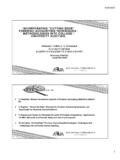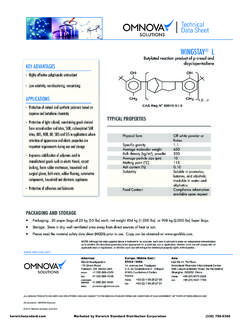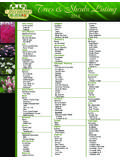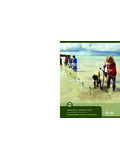Transcription of Making a West Greenland Paddle
1 Making a West Greenland Paddleby Chuck HolstThe Greenland paddleThe Greenland Paddle has become increasingly popularamong sea kayakers in North America, Europe, andother parts of the world. Apart from its romantic as-sociation with the people who taught Europeans tokayak and to roll, the narrow-bladed Greenland paddleis popular because it is easy to brace and roll with andis not very susceptible to strong winds. Also, because itslips a little at the beginning of a stroke, it is easier onthe muscles, and thus less fatiguing on day-long tripsthan wide-bladed Euro -style further benefit for northern kayakers is that the Green-land Paddle is adapted for paddling in freezing condi-tions. The shoulders where the blades and loom meetmake an ice-coated loom easier to grip, while the nar-row ends of the blades, which are immersed in waterwhile paddling, offer an ice-free grip for emergencybraces and Greenland Paddle is also popular because it is veryeasy and inexpensive to make with simple tools in ahome workshop, which is the subject of this entirely with hand tools, it is possible to makea Greenland Paddle with less than $10 worth of materialsand 24 hours of is a Greenland Paddle ?
2 A Greenland Paddle is a Paddle in the style of those tra-ditionally used by the Inuit of Greenland . It is charac-terized by long, narrow, tapering blades and a relativelyshort loom, or shaft, that is typically one-quarter and nomore than one-third the length of the Paddle . UnlikeInuit paddles across the Davis Strait, the loom is notcarved in any way that would interfere with the slidingstroke. Traditional Greenland paddles have bone tips,and usually bone edges, to protect them from sea ice,but outside Greenland and even in Greenland itself,most modern replicas are made entirely of Greenland Paddle is narrow so the hand can grasp theblade near the end without having to grasp the tip, whichon a traditional Paddle is connected to the blade by amortise and tenon joint. So the extreme width of aGreenland blade should be no wider than the paddlercan grasp between the web of the thumb and the secondjoint of the forefinger.
3 A Paddle that has a blade toowide to grasp is not a Greenland Paddle , because itcannot be used like Paddle stylesIn Greenland there are two basic Paddle styles andmany variations in between. On the east coast ofGreenland, in the Angmagssalik (or Ammassilik) district,the wood part of the Paddle flares gradually from theloom to the end of the blade (Fig. 1). The edges of theblades are made from whale ribs, the ends of whichcreate shoulders that mark the ends of the blades. Thetips of the blades are carved from the jawbones ofwhales. Typically, they are made a little wider than therest of the blade, possibly to keep the hand from slidingoff the end when the Paddle is used in the extendedposition. However, when used with the normal forwardstroke, this style tip is noisier than the West Greenlandstyle tip. This is the Paddle style used by members ofthe British Arctic Air Route Expeditions of 1930 33,led by Gino Watkins, who was taught to kayak byFig.
4 1. East Greenland 2. West Greenland 3. Storm a West Greenland Paddle - 2 -Manasse Mathaeussen, who at his death in 1989 wasthe most skilled kayaker in the west coast of Greenland , paddles typically havea shoulder carved into the wood where the blade meetsthe loom, bone edges are usually shorter and faired intothe blade, and the bone tips are more likely to be thesame width as the rest of the blade (Fig. 2). However,since there was a great deal of movement between theeast and west coasts, especially during the twentiethcentury, there are many intermediate styles as Mathaeussen himself learned to kayak on theeast coast, but spent most of his kayaking career on thewest third type of Paddle is called the storm Paddle ,because its primary use is in high winds. The stormpaddle resembles a standard Greenland Paddle , exceptthat the loom is only about as long as two fists, whilethe blades are of normal length.
5 The total length isabout the height of the paddler. This Paddle is usedonly with a full sliding stroke, which buries the bladedeep in the water while exposing little of the upper endto the winds. I carry mine as a spare on my foredeck,where it is easy to grab and roll up with should I losemy standard Greenland Paddle in a capsize. Becausethe storm Paddle is easier than the standard Paddle tomove underwater, many prefer it for of the Greenland paddleNo one knows how old the Greenland Paddle is, but itis unlikely to be the thousands of years that are some-times claimed. The ancestors of today s Greenlanders,known as the Thule culture, moved east from Alaskaand northern Canada only about a thousand years ago,about the same time that Eric the Red was settlingsouthwest Greenland . Since a different style of paddlewith a longer loom and much shorter, leaf-shapedblades was used until recently by many Inuit west ofGreenland, the Greenland Paddle may have evolvedafter the Thule Inuit reached is one ambiguous clue that the Greenland paddlemay be only a few hundred years old.
6 The oldest knownsurviving Greenland kayak, collected in 1613, has beenon display at Trinity House in Hull, Humberside,England since the early 17th century; however, thepaddle that accompanies it is of the older leaf-bladedstyle. John Brand, who took the lines of the kayak anddocumented it in his Little Kayak Book, speculates thatthe development of the Greenland Paddle may have beeninfluenced by the shape of European oars. However, theoars used with Greenland umiaks, or open boats, haverelatively wide blades, unlike either European oars orGreenland paddles, and I question whether the Euro-pean example would influence one and not the own guess is that the Greenland Paddle and thesliding stroke evolved together. The unadorned shapeand dimensions of the Paddle make it easy to slide thepaddle back and forth in the hands, and in fact,Greenlanders typically slide both hands out onto oneblade for leverage when bracing, rolling, and makingsweep turns.
7 Also, many Greenlanders incorporate asliding stroke into their forward sliding strokeIn the sliding stroke, the Paddle slides back and forththrough the hands as the kayaker strokes first on oneside, then the other. You might call it the Greenlandversion of the marathon canoe racer s sit n switchstyle, except that the hands never leave the the full sliding stroke, which is used mostly with thestorm Paddle , the paddler begins a stroke with one handnear the middle of the loom and the other on the upperblade about a shoulder width away. During the recoveryphase, the top hand slides down the blade to meet thebottom hand, and the bottom hand then slides out ontothe other blade to become the top hand for the what I call the short sliding stroke, the paddlerbegins a stroke with the bottom hand grasping the loomand the root of the bottom blade and the top handgrasping the top blade about six inches from the the recovery phase, the top hand slides downthe blade to the loom, and the bottom hand then slidesout about six inches onto the other blade to become thetop hand.
8 This stroke was formerly practiced in theAngmagssalik district of Greenland , and perhaps inother districts as well. In the film Palos Brudefaerd(Palo s Wedding), filmed by Knud Rasmussen inAngmagssalik in 1932, all the kayakers can be seenusing this Watkin s Last Expedition, F. Spencer Chapman, wholearned to kayak in Angmagssalik a year or two beforePalos Brudefaerd was filmed, says: When you arepaddling a kayak you keep on passing the Paddle to andfro in your hands so that as much of the blade aspossible is under water at each stroke. Extending thepaddle by moving it between the hands like this allowsmore control and makes bracing quicker and the kayaker is used to sliding the Paddle , it iseasy to turn a short extension of the Paddle into a longone when conditions warrant. It is because of thesliding stroke that I sometimes call the Greenlandpaddle the variable-length Paddle . Making a West Greenland Paddle - 3 - Making a West Greenland paddleThough it is now easier to buy a ready-made Greenlandpaddle than it used to be, it is far less expensive andmuch more satisfying to make your own.
9 One reason tomake your own is that the cost of materials for a Green-land Paddle is only about $10 to $20, compared to $120to $220 for a ready-made version. Another reason isthat you can custom-fit the Paddle to your dimensions;many ready-made paddles have looms that are too longor blades that are too wide for the average paddler. Athird reason is that many paddles sold as Greenlandpaddles are not as authentic as one you can article describes how to carve a West Greenlandkayak Paddle from a two-by-four. It is based on JohnHeath s article, The Do-It-Yourselfer s GreenlandPaddle, in the Winter 1987 issue of Sea Kayaker andon my own Paddle - Making experience. As you refer tothe step-by-step illustrations in Fig. 7, keep in mind thatthe column on the right shows approximately what thepaddle would look like if you cut it through the centerafter each step, while the bottom row shows sections ofthe completed Greenland Inuit made paddles from anything thatwashed up on shore.
10 John Heath recommends pine, fir,spruce, or ash. George Gronseth recommends cedarbecause it is easy to work and has soft splinters. I prefercedar for its light weight, though it does mar more easilythan some other woods. Choose a two-by-four that is atleast 1-1/2 inches by 3-1/2 inches in section and 7 to 8feet in length. It should be seasoned and straight. Askfor clear finish-grade wood. In cedar, this would be A-or B-grade. However, not all lumber yards carry finish-grade lumber, so you might have to sort through stacksof standard construction-grade lumber to find some-thing usable. Most lumber yards will let you do this, ifyou are reasonably neat about grain should be fine, straight, and more or lessparallel to the sides of the plank. Knotholes should besmall and few, if not absent entirely. Sometimes youcan find a long enough clear section in a 12-foot two-by-four when you can t find a clear 8-foot one.






